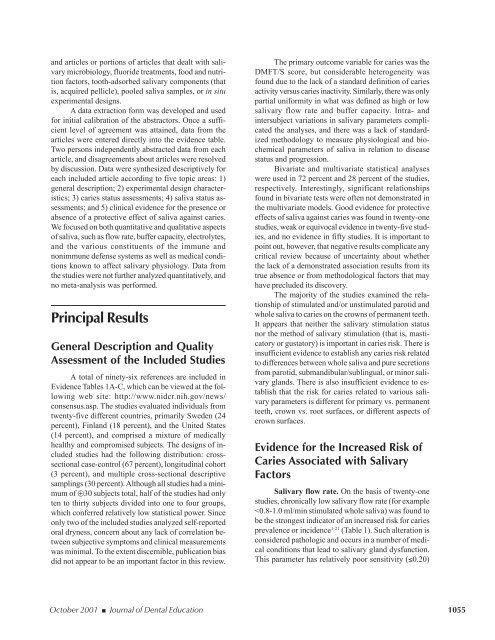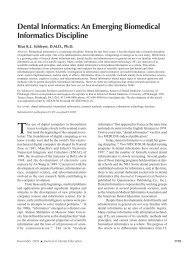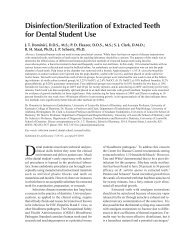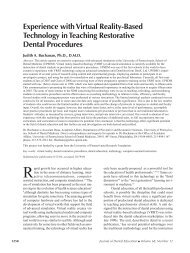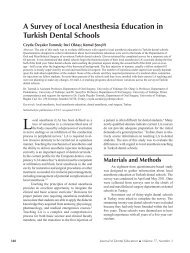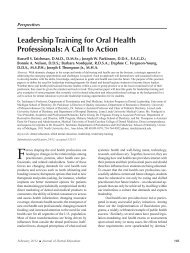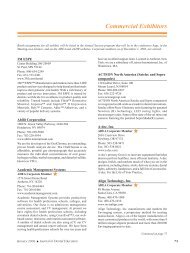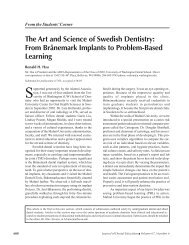Physical and chemical aspects of saliva as indicat... - ResearchGate
Physical and chemical aspects of saliva as indicat... - ResearchGate
Physical and chemical aspects of saliva as indicat... - ResearchGate
You also want an ePaper? Increase the reach of your titles
YUMPU automatically turns print PDFs into web optimized ePapers that Google loves.
<strong>and</strong> articles or portions <strong>of</strong> articles that dealt with <strong>saliva</strong>ry<br />
microbiology, fluoride treatments, food <strong>and</strong> nutrition<br />
factors, tooth-adsorbed <strong>saliva</strong>ry components (that<br />
is, acquired pellicle), pooled <strong>saliva</strong> samples, or in situ<br />
experimental designs.<br />
A data extraction form w<strong>as</strong> developed <strong>and</strong> used<br />
for initial calibration <strong>of</strong> the abstractors. Once a sufficient<br />
level <strong>of</strong> agreement w<strong>as</strong> attained, data from the<br />
articles were entered directly into the evidence table.<br />
Two persons independently abstracted data from each<br />
article, <strong>and</strong> disagreements about articles were resolved<br />
by discussion. Data were synthesized descriptively for<br />
each included article according to five topic are<strong>as</strong>: 1)<br />
general description; 2) experimental design characteristics;<br />
3) caries status <strong>as</strong>sessments; 4) <strong>saliva</strong> status <strong>as</strong>sessments;<br />
<strong>and</strong> 5) clinical evidence for the presence or<br />
absence <strong>of</strong> a protective effect <strong>of</strong> <strong>saliva</strong> against caries.<br />
We focused on both quantitative <strong>and</strong> qualitative <strong><strong>as</strong>pects</strong><br />
<strong>of</strong> <strong>saliva</strong>, such <strong>as</strong> flow rate, buffer capacity, electrolytes,<br />
<strong>and</strong> the various constituents <strong>of</strong> the immune <strong>and</strong><br />
nonimmune defense systems <strong>as</strong> well <strong>as</strong> medical conditions<br />
known to affect <strong>saliva</strong>ry physiology. Data from<br />
the studies were not further analyzed quantitatively, <strong>and</strong><br />
no meta-analysis w<strong>as</strong> performed.<br />
Principal Results<br />
General Description <strong>and</strong> Quality<br />
Assessment <strong>of</strong> the Included Studies<br />
A total <strong>of</strong> ninety-six references are included in<br />
Evidence Tables 1A-C, which can be viewed at the following<br />
web site: http://www.nidcr.nih.gov/news/<br />
consensus.<strong>as</strong>p. The studies evaluated individuals from<br />
twenty-five different countries, primarily Sweden (24<br />
percent), Finl<strong>and</strong> (18 percent), <strong>and</strong> the United States<br />
(14 percent), <strong>and</strong> comprised a mixture <strong>of</strong> medically<br />
healthy <strong>and</strong> compromised subjects. The designs <strong>of</strong> included<br />
studies had the following distribution: crosssectional<br />
c<strong>as</strong>e-control (67 percent), longitudinal cohort<br />
(3 percent), <strong>and</strong> multiple cross-sectional descriptive<br />
samplings (30 percent). Although all studies had a minimum<br />
<strong>of</strong> ⊕30 subjects total, half <strong>of</strong> the studies had only<br />
ten to thirty subjects divided into one to four groups,<br />
which conferred relatively low statistical power. Since<br />
only two <strong>of</strong> the included studies analyzed self-reported<br />
oral dryness, concern about any lack <strong>of</strong> correlation between<br />
subjective symptoms <strong>and</strong> clinical me<strong>as</strong>urements<br />
w<strong>as</strong> minimal. To the extent discernible, publication bi<strong>as</strong><br />
did not appear to be an important factor in this review.<br />
The primary outcome variable for caries w<strong>as</strong> the<br />
DMFT/S score, but considerable heterogeneity w<strong>as</strong><br />
found due to the lack <strong>of</strong> a st<strong>and</strong>ard definition <strong>of</strong> caries<br />
activity versus caries inactivity. Similarly, there w<strong>as</strong> only<br />
partial uniformity in what w<strong>as</strong> defined <strong>as</strong> high or low<br />
<strong>saliva</strong>ry flow rate <strong>and</strong> buffer capacity. Intra- <strong>and</strong><br />
intersubject variations in <strong>saliva</strong>ry parameters complicated<br />
the analyses, <strong>and</strong> there w<strong>as</strong> a lack <strong>of</strong> st<strong>and</strong>ardized<br />
methodology to me<strong>as</strong>ure physiological <strong>and</strong> bio<strong>chemical</strong><br />
parameters <strong>of</strong> <strong>saliva</strong> in relation to dise<strong>as</strong>e<br />
status <strong>and</strong> progression.<br />
Bivariate <strong>and</strong> multivariate statistical analyses<br />
were used in 72 percent <strong>and</strong> 28 percent <strong>of</strong> the studies,<br />
respectively. Interestingly, significant relationships<br />
found in bivariate tests were <strong>of</strong>ten not demonstrated in<br />
the multivariate models. Good evidence for protective<br />
effects <strong>of</strong> <strong>saliva</strong> against caries w<strong>as</strong> found in twenty-one<br />
studies, weak or equivocal evidence in twenty-five studies,<br />
<strong>and</strong> no evidence in fifty studies. It is important to<br />
point out, however, that negative results complicate any<br />
critical review because <strong>of</strong> uncertainty about whether<br />
the lack <strong>of</strong> a demonstrated <strong>as</strong>sociation results from its<br />
true absence or from methodological factors that may<br />
have precluded its discovery.<br />
The majority <strong>of</strong> the studies examined the relationship<br />
<strong>of</strong> stimulated <strong>and</strong>/or unstimulated parotid <strong>and</strong><br />
whole <strong>saliva</strong> to caries on the crowns <strong>of</strong> permanent teeth.<br />
It appears that neither the <strong>saliva</strong>ry stimulation status<br />
nor the method <strong>of</strong> <strong>saliva</strong>ry stimulation (that is, m<strong>as</strong>ticatory<br />
or gustatory) is important in caries risk. There is<br />
insufficient evidence to establish any caries risk related<br />
to differences between whole <strong>saliva</strong> <strong>and</strong> pure secretions<br />
from parotid, subm<strong>and</strong>ibular/sublingual, or minor <strong>saliva</strong>ry<br />
gl<strong>and</strong>s. There is also insufficient evidence to establish<br />
that the risk for caries related to various <strong>saliva</strong>ry<br />
parameters is different for primary vs. permanent<br />
teeth, crown vs. root surfaces, or different <strong><strong>as</strong>pects</strong> <strong>of</strong><br />
crown surfaces.<br />
Evidence for the Incre<strong>as</strong>ed Risk <strong>of</strong><br />
Caries Associated with Salivary<br />
Factors<br />
Salivary flow rate. On the b<strong>as</strong>is <strong>of</strong> twenty-one<br />
studies, chronically low <strong>saliva</strong>ry flow rate (for example<br />


